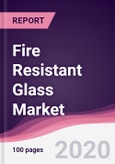The modern architecture favors transparency beyond the look because the architects prefer natural light and open spaces to regulate the design of buildings right down to their structural core. The safety measures in high rise building or complex have been the core concern for the protection of human life and property, and this is where Fire Resistant Glass comes into consideration. The Fire Resistant Glass has been the promising material to fulfil the required needs by the architect. The Fire Resistant Glass Market size is estimated to grow at a CAGR of 8.64% during the forecast period i.e. 2020-2025. Switzerland is the fastest growing market with a CAGR of 9.01%, which is mainly attributed to the growing construction activities and infrastructure development.
Fire Resistant Glass Market Outlook:
The continuing usage of glass in internal and external applications for decorative purpose in buildings has increased the demand for different forms of glass. Fire Resistant Glass is one of the main components which can be employed in the commercial construction projects to attain the purpose of decoration and creating a barrier for unwanted fire hazard. Doors and windows are the major end users for Fire Resistance Glass among other applications such as partitions, transoms, roofs, facades and others. According to a recent study by the publisher, doors and windows constitute 50% of the market share and is estimated to reach $72.81 million by 2025 during the forecast period of 2020-2025.
Fire Resistant Glass Market Growth Drivers: The Austrian building industry has excellent reputation in foreign markets and is advancing to become a powerful and important player in the Fire Resistant Glass export business. The Austrian government launched the Austrian Rural Development Program (RDP) 2014–2020 to provide better quality of life to the rural populace. Under this program, the government aims to develop agriculture, transport, energy and infrastructure for an expected investment of EUR15.4 billion (US$21.0 billion) by 2020. The Swiss building sector is recovering after a stagnant performance and is set to gain further drive in 2020 and 2020. The growth of fire resistant glass in Swiss building sector is driven by infrastructure investments and industrial-commercial construction.
Fire Resistant Glass Market Challenges: The increase in raw material prices is one of the major challenges to the growth of the Fire Resistant Glass Market. The cost of producing glass has continued to increase, driven by the rising energy costs and raw materials prices. The rise in prices of raw materials such as silica sand, soda ash, silicates, and limestone used in the manufacturing of glass is creating the barrier in the growth of the Fire Resistant Glass Market. For instance, soda ash is one of the expensive raw materials used in glass manufacturing which accounts for more than 50% of the total cost of raw materials.
Fire Resistant Glass Market Share, By Type, 2020
Fire Resistant Glass Market Research Scope:
The base year of the study is 2020, with forecast done up to 2025. The study presents a thorough analysis of the competitive landscape, taking into account the market shares of the leading companies. These provide the key market participants with the necessary business intelligence and help them understand the future of the Fire Resistant Glass Market. The assessment includes the forecast, an overview of the competitive structure, the market shares of the competitors, as well as the market trends, market demands, market drivers, market challenges, and product analysis. The market drivers and restraints have been assessed to fathom their impact over the forecast period. This report further identifies the key opportunities for growth while also detailing the key challenges and possible threats. The key areas of focus include the types of fire resistant glass and their specific applications in the Fire Resistant Glass Market.
Fire Resistant Glass Market Report: Industry Coverage
Types of Fire Resistant Glass: Wired Fire Resistant Glass, Ceramic Fire Resistant Glass, Laminated Fire Resistant Glass and Others.
Applications of Fire Resistant Glass: Partitions, Doors and Windows, Transoms and others.
The Fire Resistant Glass Market report also analyzes the global region for the market.
The regions and countries covered in the study include:
Europe (Switzerland and Austria)
Fire Resistant Glass Market Key Players Perspective:
NSG Pilinkton is the main company for the production of Fire Resistant Glass. The company has its headquarters in U.K and operates in North America, South America, EMEA and Asia Pacific regions. Vetrotech Saint-Gobain is the next leading player in the Fire Resistant Glass Market. The company has its headquarters in Switzerland. It has businesses with regional pillars in Asia Pacific, Europe, Middle East, Africa, and North & South America.
Fire Resistant Glass Market Trends:
One of the trends in the Fire Resistant Glass Market is that fire resistant glass is widely used in residential and commercial buildings. Fire Resistance Glass creates a protective barrier preventing the spreading of fire, smoke and gases to neighboring areas which are not on fire. Fire Resistant Glass is classified based on integrity, radiation control and insulation. It is not only used for its fire resistive property but also for the transparency properties which makes it suitable for the smooth passing of light to provide better light condition and ventilation inside the room. Also, fire resistant glass is being utilized as a fire pit and fire place media and as a crafting item.
Table of Contents
Methodology

LOADING...








